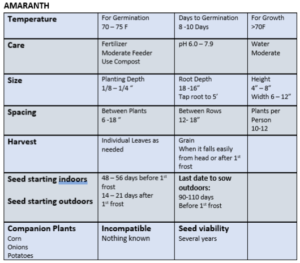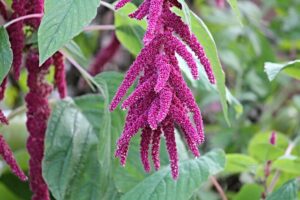Unleash your green thumb and embrace the vibrant world of growing Amaranth! This splendid plant is a breeze to grow. Sow it in late spring, give it plenty of sunshine, a sprinkle of water, and watch its radiant hues come to life. From its nutritious leaves to its versatile seeds, Amaranth is a garden’s treasure.

Cultivars of Amaranth
- Amaranthus caudatus: Known for its long, trailing flowers, commonly referred to as “love-lies-bleeding.”
- Amaranthus cruentus: Also known as “Prince-of-Wales feather,” recognized for its feathery, upright flowers.
- Amaranthus hypochondriacus: Popularly known as “prince’s feather,” characterized by erect, dense, purple, or red flowers.
Best Cultivars for Seed and Flour Production
When it comes to the production of seeds and flour, certain cultivars of amaranth stand out.
- Amaranthus hypochondriacus: This cultivar is renowned for its high-quality seeds, which are often used in the food industry for their rich protein content and pleasant, mild flavor.
- Amaranthus cruentus: Known for its prolific seed production, this cultivar is a top choice for those interested in grinding amaranth into flour. The seeds of Amaranthus cruentus are small but plentiful, yielding a nutritious, gluten-free flour that can be used in a variety of culinary applications.
These two varieties are thus recommended for gardeners interested in growing amaranth for seed and flour production.
Best Cultivars for Greens
There are specific cultivars of amaranth that are especially suited to providing lush, edible greens. These varieties are ideally suited for harvest while young and tender, usually just a few weeks after planting.
- Amaranthus dubius: Also known as tropical or smooth amaranth, this cultivar is a popular choice for its tender, flavorful leaves. It is a fast-growing variety that can produce a bounty of greens in a short amount of time.
- Amaranthus tricolor: Known for its striking multi-colored foliage, this cultivar is not only a garden beauty but also offers flavorful and nutritious greens. The young leaves can be harvested and used similar to spinach, making it an excellent choice for fresh salads or cooked dishes.
These two varieties hold high esteem amongst gardeners interested in growing amaranth primarily for leaf production.
Parts of Amaranth Used
- Leaves: Can be used in salads or cooked like spinach.
- Seeds: Can be ground into flour, popped like popcorn, or used as a grain substitute.
- Flowers: Can be used for decorative purposes, while certain species have edible seeds.
Growing Information
Planting Time
Amaranth enjoys warm weather and is typically sown in late spring when the soil temperature has adequately warmed. Its seeds require a soil temperature of at least 18°C (65°F) to germinate effectively. Planting during this time ensures that the amaranth plant can take full advantage of the long summer days and grow to its full potential before the arrival of the cooler autumn season.
Soil Requirements
Amaranth thrives best in well-drained, fertile soil. Ideal soil conditions for amaranth should have a pH between 6 and 7.5. This pH range ensures the soil has an optimal balance of acidity and alkalinity, allowing maximum nutrient absorption. Soils with these characteristics offer the best environment for amaranth, promoting robust growth and a healthy, productive plant.
Sunlight Requirements
Amaranth is a sun-loving plant and thrives best under full sun exposure. It requires at least 6 hours of direct sunlight per day to grow healthily and produce a good yield. The ample sunlight ensures the plant can photosynthesize efficiently, promoting vigorous growth and abundant leaf and seed production. Limited sun exposure can result in leggy plants with feeble stems and poor harvest. Therefore, when selecting a planting spot for your amaranth, choose a location that receives abundant sunlight throughout the day.
Watering Requirements
Amaranth necessitates regular watering, particularly during periods of drought. Consistent moisture is vital to maintain healthy growth and yield. However, caution must be exercised to prevent overwatering, as this can lead to root rot and other water-related diseases. Despite its preference for moisture, amaranth exhibits a reasonable degree of drought tolerance. Overwatering can be more detrimental to the plant than occasional dry spells. Thus, while ensuring your amaranth stays hydrated, it’s crucial to allow the soil to dry out slightly between watering periods. This balance prevents waterlogging and fosters the plant’s overall health and productivity.
Feeding Requirements
For successful growth and high yield, amaranth should be fed with a balanced organic fertilizer. The fertilizer you choose should ideally contain equal proportions of nitrogen, phosphorus, and potassium. Nitrogen promotes healthy leaf growth, phosphorus aids root development, and potassium helps with overall plant health and disease resistance. Be sure to follow the product’s instructions to determine the proper amount and frequency of application. Over-fertilizing or applying fertilizer too frequently can be detrimental to the plant, resulting in burned foliage or excessive leaf growth at the expense of seeds. Therefore, use caution and feed your amaranth in moderation to ensure optimal growth and a bountiful harvest.###
Harvesting
Amaranth leaves can be harvested when they are young and tender, typically when the plant has reached about one to two feet in height. Young leaves are more flavorful and nutritious, ideal for salads and sautés. As for the seeds, they should be harvested once the flowers have dried out and the seeds begin to fall. This usually happens late in the growing season. To harvest, simply shake the dried flower heads over a paper bag or bucket to collect the tiny, grain-like seeds. These can be used in a variety of dishes, such as bread, porridge, or as a rice substitute. Always remember to save some seeds for planting in the following season.
How to Winnow Seeds
Winnowing is a process used to separate the seeds from any remaining plant debris. To separate the collected seeds, place them in a shallow bowl and delicately blow away the lighter chaff, while ensuring the heavier seeds remain at the bottom. Alternatively, you can employ a fan or sieve to achieve the same outcome. Once your amaranth seeds are free of debris, store them in a cool, dry place until you are ready to use them. They can stay viable for several years if stored properly.
Additional Tips
- Amaranth is a versatile plant that can grow in various conditions and climates. However, it thrives in warm temperatures and full sun.
- Adequate watering is crucial for the growth and production of amaranth. Keep the soil consistently moist, but not waterlogged.
- To promote bushier growth, pinch off the tips of young plants to encourage branching.
- Amaranth is a self-seeding annual, so it will likely come back on its own in subsequent years if allowed to go to seed and drop its seeds.
Final Thoughts
Amaranth is a highly nutritious and easy-to-grow plant that can add variety to your garden and meals. With a little bit of care and attention, you can enjoy its beautiful flowers, flavorful leaves, and tasty seeds year after year. So why not give it a try in your garden? You’ll be rewarded with a bountiful harvest and the satisfaction of growing your own food. Happy planting


